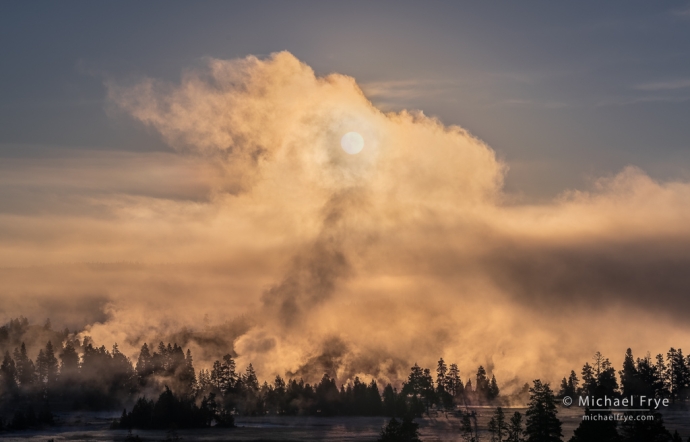
Sun rising through fog and steam, Yellowstone NP, Wyoming. Standing on a low hill, I moved to position the sun behind the column of steam, in order to avoid lens flare and prevent the sun itself from being completely blown out. With this extreme constrast I bracketed five frames, two stops apart, and blended the exposures with Lightroom’s HDR Merge. 100mm, bracketed shutter speeds, f/11, ISO 100.
If you read this blog regularly you know that I love fog and mist. And few places generate fog and mist as consistently as the thermal areas of Yellowstone during cold weather. Warm, moist air rising from the geysers and hot springs into the colder surrounding atmosphere creates a perfect recipe for mist formation.
During the first part of our stay in Yellowstone the daytime highs were in the low to mid 80s. But the daily temperature fluctuations were tremendous, so the next morning the thermal areas would be near freezing – a difference of around 50 degrees Fahrenheit (or about 28 degrees Celsius). So despite unusually warm days for early September, we still found plenty of steam and fog in the mornings. And toward the end of our stay a cold front came through, temps dropped, and we saw even more mist.
So I was a happy camper. Well not so happy waking up at 5:30 in the morning in the cold and dark, but quite happy when we got out to the thermal areas and saw all that mist. There’s nothing like a compelling photo subject to make you forget the cold. (And in Yellowstone you can always warm up by standing near a hot spring.)
These steamy, misty scenes are often quite dynamic, as the slightest change in the wind will cause the columns of steam to move one way or another. And of course the light changes too. I love backlit mist, so usually I’m trying to look toward the rising sun when photographing these misty morning scenes. As the sun gets higher the light loses some of its warm color, but penetrates more deeply down through the mist, silhouetting trees, backlighting thermal pools, and often creating beautifully complex fluctuations between light and dark.
The fast-moving interplay between mist and light requires either speed or patience; that is, you have to be quick enough to capture something before it changes, or patient enough to wait for the same conditions to recur.
Anyone who’s watched me photograph such situations knows that I rarely stand around and wait, because too often those fleeting, beautiful moments never happen again. So I’m constantly in motion, changing my camera position, changing lenses, zooming in or out, adjusting my settings – doing my best to photograph little bits of magic before they disappear.
This approach works for me only because I can act quickly. I know my equipment and technique inside out, and hardly have to think about camera settings, or how to get everything in focus, or any of that technical minutia that can clutter your mind, slow you down, and blunt your creativity.
So this may seem contradictory, but mastering your equipment and technique is actually an important part of the creative process. The less you have to think about technical stuff, the more creative you’re likely to be. I think it’s immensely helpful to develop and practice a solid, consistent field routine, as I outline in this earlier post.
That kind of intuitive technical mastery is especially helpful in dynamic situations, when conditions change quickly, and you might only have a few seconds to capture a beautiful, fleeting moment – like those misty mornings in Yellowstone.
It also helps to be able to compose quickly. This comes with experience, but photographic “cross-training” can also help. Experience photographing street scenes, wildlife, or sports can help you learn to make swift decisions about framing, and those skills come in handy when photographing fast-changing landscape scenes.
I enjoy photographing these dynamic situations. It’s challenging, but I like challenges. And it’s satisfying to capture a unique moment of natural beauty that will never be repeated.
Since I spent so much time photographing these misty scenes in Yellowstone, I’m dividing the images into two groups. Here’s one set, and I’ll post the second set soon.
— Michael Frye
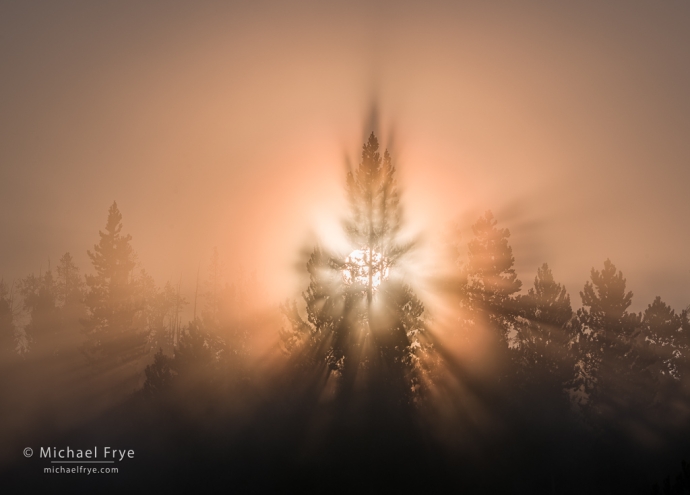
Sunbeams and corona, Yellowstone NP, Wyoming. As the sun rose through a bank of fog I moved to position it behind a tree to show the radiating sunbeams and corona. Another high-contrast situation where I bracketed five frames, two stops apart, and blended them with Lightroom’s HDR Merge. 215mm, bracketed shutter speeds, f/16, ISO 100.
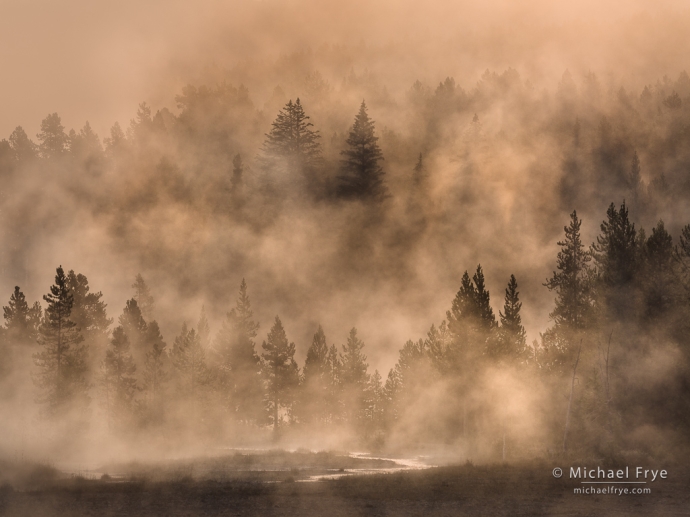
Trees, mist, and stream in a thermal area, Yellowstone NP, Wyoming. As the sun rose high enough to backlight the mist and trees on this hillside, I moved to a spot where I could position the little stream underneath the trees. As always with scenes like this, I captured a series of frames (13 altogether) with the same composition and settings, and picked one that I thought had the best arrangement of mist. 206mm, 1/90 sec. at f/16, ISO 100.
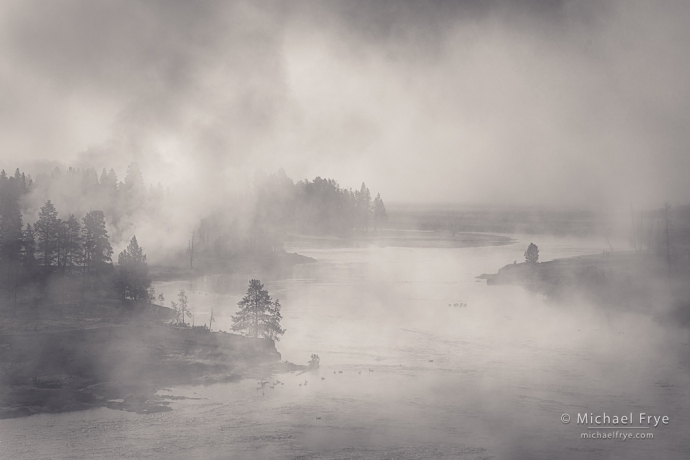
Yellowstone River with fog, Yellowstone NP, Wyoming. I found this elevated view of the river and captured a series of frames as the mist changed. 94mm, 1/1000 sec. at f/11, ISO 100.
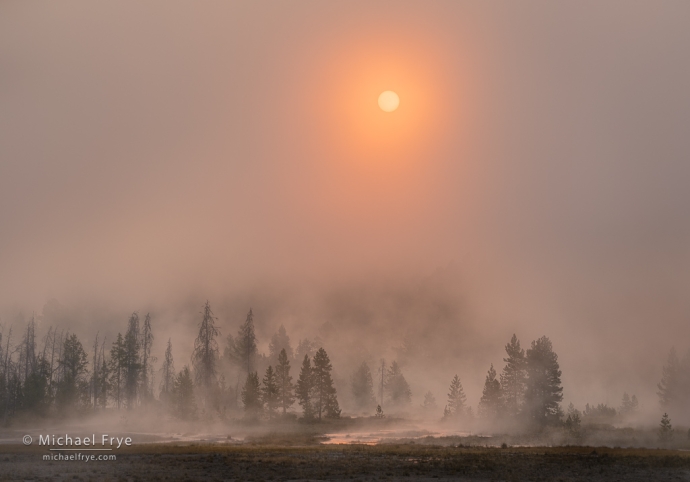
Misty sunrise, Yellowstone NP, Wyoming. When I saw the sun appear through the fog I literally ran along a road to position it above this group of trees. 100mm, three bracketed frames, two stops apart, f/11, ISO 100.
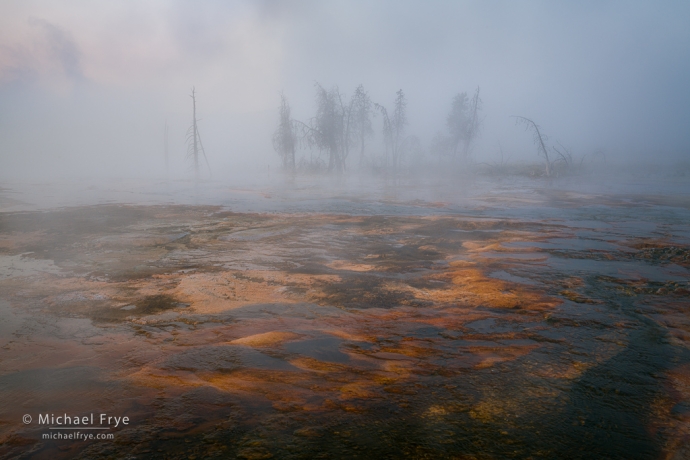
Bacterial mats and morning mist, Yellowstone NP, Wyoming. I was attracted to the row of trees in the fog, and moved back and forth on a boardwalk to find a foreground that I liked. 35mm, 1/6 sec. at f/16, ISO 100.
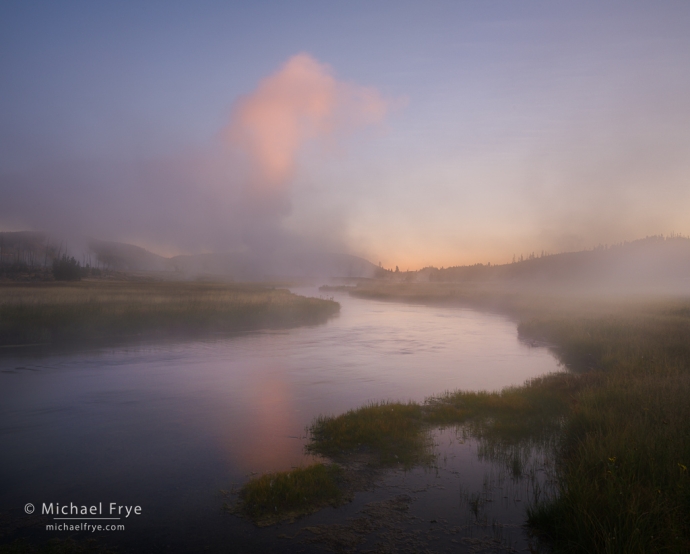
Creek with fog and steam from a thermal area, sunrise, Yellowstone NP, Wyoming. I noticed this stretch of creek, thinking it might look good with fog, and came back the next morning to find just what I was looking for. Unlike most of the images here, this scene was sidelit, rather than backlit, with early sunlight catching the column of steam while the foreground was still in shade. 24mm, 1 second at f/16, ISO 100, four-stop ND filter.
Related Posts: Yellowstone’s Dynamic Landscape; Developing a Solid Field Routine
Michael Frye is a professional photographer specializing in landscapes and nature. He is the author or principal photographer of The Photographer’s Guide to Yosemite, Yosemite Meditations, Yosemite Meditations for Women, Yosemite Meditations for Adventurers, and Digital Landscape Photography: In the Footsteps of Ansel Adams and the Great Masters. He has also written three eBooks: Light & Land: Landscapes in the Digital Darkroom, Exposure for Outdoor Photography, and Landscapes in Lightroom: The Essential Step-by-Step Guide. Michael has written numerous magazine articles on the art and technique of photography, and his images have been published in over thirty countries around the world. Michael has lived either in or near Yosemite National Park since 1983, currently residing just outside the park in Mariposa, California.









Lovely series and very useful from a learning perspective. You have the attitude and approach of the best teachers!
Thanks Claude – glad you found this helpful.
I love this series of misty, foggy scenes! Thank you, Michael m for sharing.
Thank you Vivienne!
Thanks, Michael, for this informative post with your beautiful misty images! Just gorgeous. I love the creek with fog and steam photo. Your comment about a solid field routine led me back to a post you made in 2020 about this subject, which is something I need to be better at—thanks for that too! I’m headed down to the Housekeeping Camp in Yosemite in a couple weeks and am hopeful to capturing a few good autumn images. All best to you and Claudia (my new FB friend).
You’re welcome Bob – glad you found this helpful. And I hope you have a great time in Yosemite!
Thank you. I too love mist. It doesn’t seem to happen much here. More likely at night.These shots make me get the camera and go.
Thanks
Thanks very much Lynn!
What a wonderful set of images Michael! I’m so glad we were all able to spend some time together, it went by too fast!
Thanks so much David! It did go by too fast, but I’m glad we got to hang out with you and Jennifer a bit.
Could you tell me which creek is in the last photo? I’m not a photographer, I’m just trying to find that spot. Thanks!
I like your saying « These steamy, misty scenes are often quite dynamic, as the slightest change in the wind will cause the columns of steam to move one way or another. » Could I use it for my video of Yellowstone misty morning with your name mentioned ?
Sorry, no, you don’t have my permission.
Okay. It’s a pity that I can’t use your beautiful sentence. Since my native language is not English, I don’t think I can write such a beautiful sentence myself.